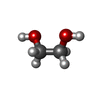[English] 日本語
 Yorodumi
Yorodumi- PDB-3myx: Crystal structure of a PSPTO_0244 (Protein with unknown function ... -
+ Open data
Open data
- Basic information
Basic information
| Entry | Database: PDB / ID: 3myx | ||||||
|---|---|---|---|---|---|---|---|
| Title | Crystal structure of a PSPTO_0244 (Protein with unknown function which belongs to Pfam DUF861 family) from Pseudomonas syringae pv. tomato str. DC3000 at 1.30 A resolution | ||||||
 Components Components | uncharacterized protein PSPTO_0244 | ||||||
 Keywords Keywords | STRUCTURAL GENOMICS / UNKNOWN FUNCTION / Protein of unknown function (DUF861) / Cupin_3 (PF05899) / Joint Center for Structural Genomics / JCSG / Protein Structure Initiative / PSI-2 | ||||||
| Function / homology | (S)-ureidoglycine aminohydrolase, cupin domain / EutQ-like cupin domain / RmlC-like cupin domain superfamily / Jelly Rolls / RmlC-like jelly roll fold / Jelly Rolls / Sandwich / Mainly Beta / (S)-ureidoglycine aminohydrolase cupin domain-containing protein Function and homology information Function and homology information | ||||||
| Biological species |  Pseudomonas syringae pv. tomato (bacteria) Pseudomonas syringae pv. tomato (bacteria) | ||||||
| Method |  X-RAY DIFFRACTION / X-RAY DIFFRACTION /  SYNCHROTRON / SYNCHROTRON /  MAD / Resolution: 1.3 Å MAD / Resolution: 1.3 Å | ||||||
 Authors Authors | Joint Center for Structural Genomics (JCSG) | ||||||
 Citation Citation |  Journal: To be published Journal: To be publishedTitle: Crystal structure of a PSPTO_0244 (Protein with unknown function which belongs to Pfam DUF861 family) from Pseudomonas syringae pv. tomato str. DC3000 at 1.30 A resolution Authors: Joint Center for Structural Genomics (JCSG) | ||||||
| History |
|
- Structure visualization
Structure visualization
| Structure viewer | Molecule:  Molmil Molmil Jmol/JSmol Jmol/JSmol |
|---|
- Downloads & links
Downloads & links
- Download
Download
| PDBx/mmCIF format |  3myx.cif.gz 3myx.cif.gz | 236.1 KB | Display |  PDBx/mmCIF format PDBx/mmCIF format |
|---|---|---|---|---|
| PDB format |  pdb3myx.ent.gz pdb3myx.ent.gz | 190.1 KB | Display |  PDB format PDB format |
| PDBx/mmJSON format |  3myx.json.gz 3myx.json.gz | Tree view |  PDBx/mmJSON format PDBx/mmJSON format | |
| Others |  Other downloads Other downloads |
-Validation report
| Summary document |  3myx_validation.pdf.gz 3myx_validation.pdf.gz | 450.3 KB | Display |  wwPDB validaton report wwPDB validaton report |
|---|---|---|---|---|
| Full document |  3myx_full_validation.pdf.gz 3myx_full_validation.pdf.gz | 454.1 KB | Display | |
| Data in XML |  3myx_validation.xml.gz 3myx_validation.xml.gz | 28.6 KB | Display | |
| Data in CIF |  3myx_validation.cif.gz 3myx_validation.cif.gz | 45.7 KB | Display | |
| Arichive directory |  https://data.pdbj.org/pub/pdb/validation_reports/my/3myx https://data.pdbj.org/pub/pdb/validation_reports/my/3myx ftp://data.pdbj.org/pub/pdb/validation_reports/my/3myx ftp://data.pdbj.org/pub/pdb/validation_reports/my/3myx | HTTPS FTP |
-Related structure data
| Similar structure data | |
|---|---|
| Other databases |
- Links
Links
- Assembly
Assembly
| Deposited unit | 
| ||||||||
|---|---|---|---|---|---|---|---|---|---|
| 1 | 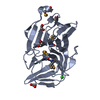
| ||||||||
| 2 | 
| ||||||||
| Unit cell |
| ||||||||
| Details | CRYSTAL PACKING ANALYSIS SUPPORTS THE ASSIGNMENT OF A MONOMER AS THE SIGNIFICANT OLIGOMERIC FORM IN SOLUTION. SIZE-EXCLUSION CHROMATOGRAPHY COUPLED WITH STATIC LIGHT SCATTERING SUGGEST A DIMER AS THE SIGNIFICANT OLIGOMERIC FORM IN SOLUTION. |
- Components
Components
| #1: Protein | Mass: 25674.059 Da / Num. of mol.: 2 Source method: isolated from a genetically manipulated source Source: (gene. exp.)  Pseudomonas syringae pv. tomato (bacteria) Pseudomonas syringae pv. tomato (bacteria)Strain: DC3000 / Gene: PSPTO0244, PSPTO_0244 / Plasmid: SpeedET / Production host:  #2: Chemical | #3: Chemical | ChemComp-EDO / #4: Water | ChemComp-HOH / | Has protein modification | Y | Sequence details | THIS CONSTRUCT WAS EXPRESSED WITH A PURIFICATION TAG MGSDKIHHHHHHENLYFQG. THE TAG WAS REMOVED WITH ...THIS CONSTRUCT WAS EXPRESSED WITH A PURIFICATI | |
|---|
-Experimental details
-Experiment
| Experiment | Method:  X-RAY DIFFRACTION / Number of used crystals: 1 X-RAY DIFFRACTION / Number of used crystals: 1 |
|---|
- Sample preparation
Sample preparation
| Crystal | Density Matthews: 2.07 Å3/Da / Density % sol: 40.69 % Description: DATA WERE SCALED USING XSCALE WITH FRIEDEL PAIRS KEPT AS SEPARATE WHEN COMPUTING R-MERGE, COMPLETENESS AND Crystal grow | Temperature: 277 K / Method: vapor diffusion, sitting drop / pH: 6.3 | Details: 0.2000M NH4Cl, 20.0000% PEG-3350, No Buffer pH 6.3, NANODROP, VAPOR DIFFUSION, SITTING DROP, temperature 277K |
|---|
-Data collection
| Diffraction | Mean temperature: 100 K | |||||||||||||||||||||||||||||||||||||||||||||||||||||||||||||||||||||||||||||
|---|---|---|---|---|---|---|---|---|---|---|---|---|---|---|---|---|---|---|---|---|---|---|---|---|---|---|---|---|---|---|---|---|---|---|---|---|---|---|---|---|---|---|---|---|---|---|---|---|---|---|---|---|---|---|---|---|---|---|---|---|---|---|---|---|---|---|---|---|---|---|---|---|---|---|---|---|---|---|
| Diffraction source | Source:  SYNCHROTRON / Site: SYNCHROTRON / Site:  SSRL SSRL  / Beamline: BL11-1 / Wavelength: 0.91837,0.97913,0.97879 / Beamline: BL11-1 / Wavelength: 0.91837,0.97913,0.97879 | |||||||||||||||||||||||||||||||||||||||||||||||||||||||||||||||||||||||||||||
| Detector | Type: MARMOSAIC 325 mm CCD / Detector: CCD / Date: Dec 3, 2009 / Details: Flat mirror (vertical focusing) | |||||||||||||||||||||||||||||||||||||||||||||||||||||||||||||||||||||||||||||
| Radiation | Monochromator: Single crystal Si(111) bent monochromator (horizontal focusing) Protocol: MAD / Monochromatic (M) / Laue (L): M / Scattering type: x-ray | |||||||||||||||||||||||||||||||||||||||||||||||||||||||||||||||||||||||||||||
| Radiation wavelength |
| |||||||||||||||||||||||||||||||||||||||||||||||||||||||||||||||||||||||||||||
| Reflection | Resolution: 1.3→28.759 Å / Num. obs: 101752 / % possible obs: 96.4 % / Observed criterion σ(I): -3 / Biso Wilson estimate: 8.663 Å2 / Rmerge(I) obs: 0.042 / Net I/σ(I): 12.07 | |||||||||||||||||||||||||||||||||||||||||||||||||||||||||||||||||||||||||||||
| Reflection shell |
|
-Phasing
| Phasing | Method:  MAD MAD |
|---|
- Processing
Processing
| Software |
| ||||||||||||||||||||||||||||||||||||||||||||||||||||||||||||||||||||||||||||||||||||||||||||||||||||
|---|---|---|---|---|---|---|---|---|---|---|---|---|---|---|---|---|---|---|---|---|---|---|---|---|---|---|---|---|---|---|---|---|---|---|---|---|---|---|---|---|---|---|---|---|---|---|---|---|---|---|---|---|---|---|---|---|---|---|---|---|---|---|---|---|---|---|---|---|---|---|---|---|---|---|---|---|---|---|---|---|---|---|---|---|---|---|---|---|---|---|---|---|---|---|---|---|---|---|---|---|---|
| Refinement | Method to determine structure:  MAD / Resolution: 1.3→28.759 Å / Cor.coef. Fo:Fc: 0.98 / Cor.coef. Fo:Fc free: 0.972 / Occupancy max: 1 / Occupancy min: 0.15 / SU B: 1.296 / SU ML: 0.025 / Cross valid method: THROUGHOUT / σ(F): 0 / ESU R Free: 0.043 MAD / Resolution: 1.3→28.759 Å / Cor.coef. Fo:Fc: 0.98 / Cor.coef. Fo:Fc free: 0.972 / Occupancy max: 1 / Occupancy min: 0.15 / SU B: 1.296 / SU ML: 0.025 / Cross valid method: THROUGHOUT / σ(F): 0 / ESU R Free: 0.043 Stereochemistry target values: MAXIMUM LIKELIHOOD WITH PHASES Details: 1.HYDROGENS HAVE BEEN ADDED IN THE RIDING POSITIONS. 2.A MET-INHIBITION PROTOCOL WAS USED FOR SELENOMETHIONINE INCORPORATION DURING PROTEIN EXPRESSION. THE OCCUPANCY OF THE SE ATOMS IN THE ...Details: 1.HYDROGENS HAVE BEEN ADDED IN THE RIDING POSITIONS. 2.A MET-INHIBITION PROTOCOL WAS USED FOR SELENOMETHIONINE INCORPORATION DURING PROTEIN EXPRESSION. THE OCCUPANCY OF THE SE ATOMS IN THE MSE RESIDUES WAS REDUCED TO 0.75 FOR THE REDUCED SCATTERING POWER DUE TO PARTIAL S-MET INCORPORATION. 3.CHLORIDE (CL) AND 1,2-ETHANEDIOL (EDO) FROM THE CRYSTALLIZATION AND CRYOPROTECTANT SOLUTIONS HAVE BEEN MODELED. 4.ELECTRON DENSITY FOR RESIDUES A201-A203 WERE POOR AND THIS REGION HAS BEEN MODELED BASED ON THE CORRESPONDING PORTION IN CHAIN B.
| ||||||||||||||||||||||||||||||||||||||||||||||||||||||||||||||||||||||||||||||||||||||||||||||||||||
| Solvent computation | Ion probe radii: 0.8 Å / Shrinkage radii: 0.8 Å / VDW probe radii: 1.4 Å / Solvent model: BABINET MODEL WITH MASK | ||||||||||||||||||||||||||||||||||||||||||||||||||||||||||||||||||||||||||||||||||||||||||||||||||||
| Displacement parameters | Biso max: 122.15 Å2 / Biso mean: 13.022 Å2 / Biso min: 3.68 Å2
| ||||||||||||||||||||||||||||||||||||||||||||||||||||||||||||||||||||||||||||||||||||||||||||||||||||
| Refinement step | Cycle: LAST / Resolution: 1.3→28.759 Å
| ||||||||||||||||||||||||||||||||||||||||||||||||||||||||||||||||||||||||||||||||||||||||||||||||||||
| Refine LS restraints |
| ||||||||||||||||||||||||||||||||||||||||||||||||||||||||||||||||||||||||||||||||||||||||||||||||||||
| LS refinement shell | Resolution: 1.3→1.334 Å / Total num. of bins used: 20
|
 Movie
Movie Controller
Controller


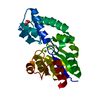
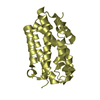
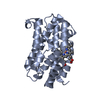





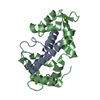

 PDBj
PDBj

